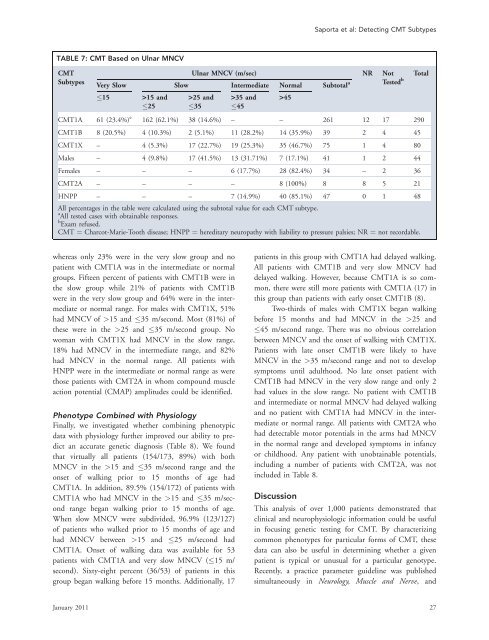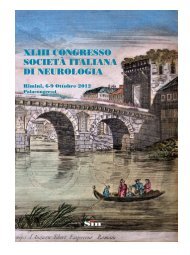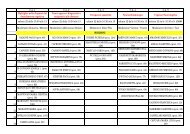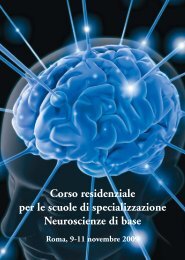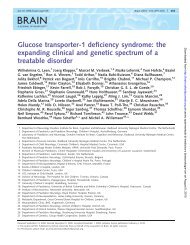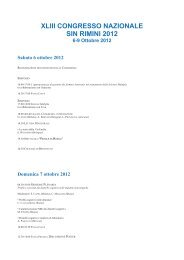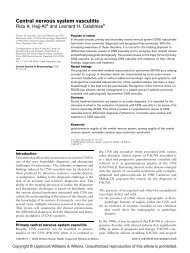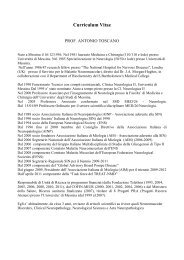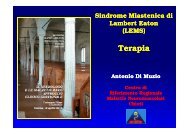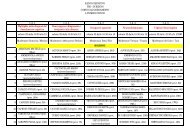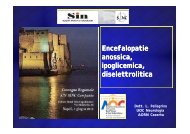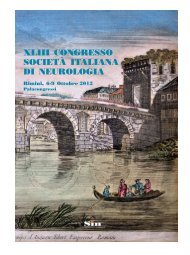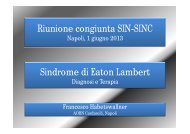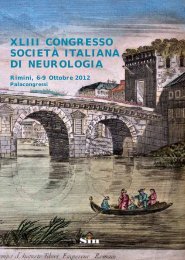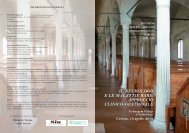Charcot-Marie-Tooth disease subtypes and genetic ... - ResearchGate
Charcot-Marie-Tooth disease subtypes and genetic ... - ResearchGate
Charcot-Marie-Tooth disease subtypes and genetic ... - ResearchGate
You also want an ePaper? Increase the reach of your titles
YUMPU automatically turns print PDFs into web optimized ePapers that Google loves.
Saporta et al: Detecting CMT SubtypesTABLE 7: CMT Based on Ulnar MNCVCMTSubtypesUlnar MNCV (m/sec) NR NotVery Slow Slow Intermediate Normal Subtotal a Tested b15 >15 <strong>and</strong> >25 <strong>and</strong> >35 <strong>and</strong> >4525 35 45CMT1A 61 (23.4%) e 162 (62.1%) 38 (14.6%) – – 261 12 17 290CMT1B 8 (20.5%) 4 (10.3%) 2 (5.1%) 11 (28.2%) 14 (35.9%) 39 2 4 45CMT1X – 4 (5.3%) 17 (22.7%) 19 (25.3%) 35 (46.7%) 75 1 4 80Males – 4 (9.8%) 17 (41.5%) 13 (31.71%) 7 (17.1%) 41 1 2 44Females – – – 6 (17.7%) 28 (82.4%) 34 – 2 36CMT2A – – – – 8 (100%) 8 8 5 21HNPP – – – 7 (14.9%) 40 (85.1%) 47 0 1 48All percentages in the table were calculated using the subtotal value for each CMT subtype.a All tested cases with obtainable responses.b Exam refused.CMT ¼ <strong>Charcot</strong>-<strong>Marie</strong>-<strong>Tooth</strong> <strong>disease</strong>; HNPP ¼ hereditary neuropathy with liability to pressure palsies; NR ¼ not recordable.Totalwhereas only 23% were in the very slow group <strong>and</strong> nopatient with CMT1A was in the intermediate or normalgroups. Fifteen percent of patients with CMT1B were inthe slow group while 21% of patients with CMT1Bwere in the very slow group <strong>and</strong> 64% were in the intermediateor normal range. For males with CMT1X, 51%had MNCV of >15 <strong>and</strong> 35 m/second. Most (81%) ofthese were in the >25 <strong>and</strong> 35 m/second group. Nowoman with CMT1X had MNCV in the slow range,18% had MNCV in the intermediate range, <strong>and</strong> 82%had MNCV in the normal range. All patients withHNPP were in the intermediate or normal range as werethose patients with CMT2A in whom compound muscleaction potential (CMAP) amplitudes could be identified.Phenotype Combined with PhysiologyFinally, we investigated whether combining phenotypicdata with physiology further improved our ability to predictan accurate <strong>genetic</strong> diagnosis (Table 8). We foundthat virtually all patients (154/173, 89%) with bothMNCV in the >15 <strong>and</strong> 35 m/second range <strong>and</strong> theonset of walking prior to 15 months of age hadCMT1A. In addition, 89.5% (154/172) of patients withCMT1A who had MNCV in the >15 <strong>and</strong> 35 m/secondrange began walking prior to 15 months of age.When slow MNCV were subdivided, 96.9% (123/127)of patients who walked prior to 15 months of age <strong>and</strong>had MNCV between >15 <strong>and</strong> 25 m/second hadCMT1A. Onset of walking data was available for 53patients with CMT1A <strong>and</strong> very slow MNCV (15 m/second). Sixty-eight percent (36/53) of patients in thisgroup began walking before 15 months. Additionally, 17patients in this group with CMT1A had delayed walking.All patients with CMT1B <strong>and</strong> very slow MNCV haddelayed walking. However, because CMT1A is so common,there were still more patients with CMT1A (17) inthis group than patients with early onset CMT1B (8).Two-thirds of males with CMT1X began walkingbefore 15 months <strong>and</strong> had MNCV in the >25 <strong>and</strong>45 m/second range. There was no obvious correlationbetween MNCV <strong>and</strong> the onset of walking with CMT1X.Patients with late onset CMT1B were likely to haveMNCV in the >35 m/second range <strong>and</strong> not to developsymptoms until adulthood. No late onset patient withCMT1B had MNCV in the very slow range <strong>and</strong> only 2had values in the slow range. No patient with CMT1B<strong>and</strong> intermediate or normal MNCV had delayed walking<strong>and</strong> no patient with CMT1A had MNCV in the intermediateor normal range. All patients with CMT2A whohad detectable motor potentials in the arms had MNCVin the normal range <strong>and</strong> developed symptoms in infancyor childhood. Any patient with unobtainable potentials,including a number of patients with CMT2A, was notincluded in Table 8.DiscussionThis analysis of over 1,000 patients demonstrated thatclinical <strong>and</strong> neurophysiologic information could be usefulin focusing <strong>genetic</strong> testing for CMT. By characterizingcommon phenotypes for particular forms of CMT, thesedata can also be useful in determining whether a givenpatient is typical or unusual for a particular genotype.Recently, a practice parameter guideline was publishedsimultaneously in Neurology, Muscle <strong>and</strong> Nerve, <strong>and</strong>January 2011 27


